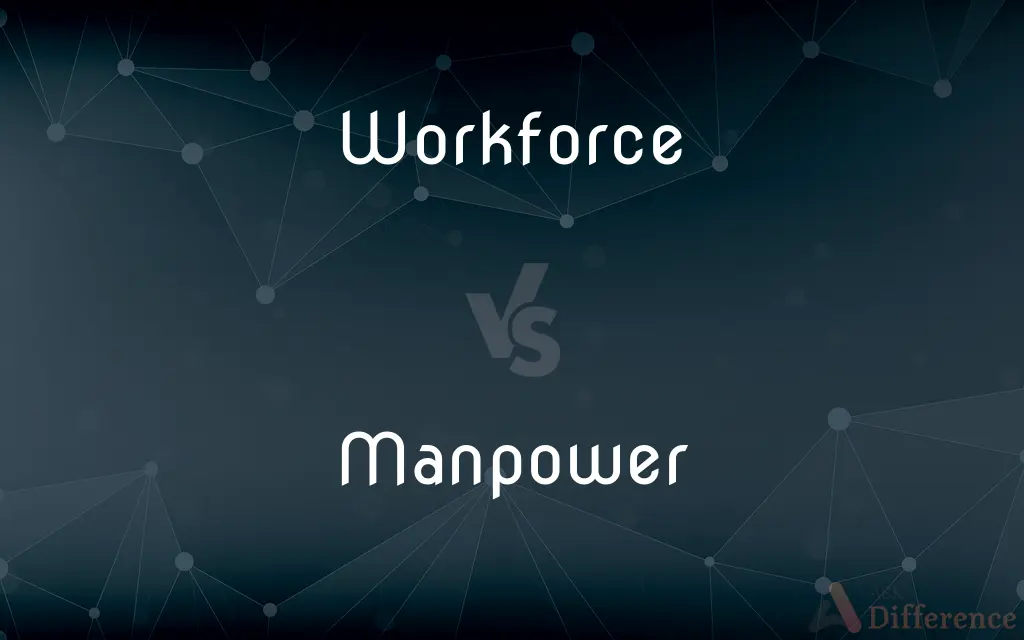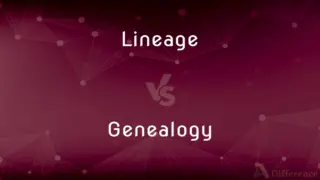Workforce vs. Manpower — What's the Difference?
By Urooj Arif & Fiza Rafique — Updated on April 1, 2024
Workforce refers to the people engaged in or available for work, either in a country or a specific sector, emphasizing the collective aspect. Manpower highlights the human physical effort and strength available for work, often focusing on quantity.

Difference Between Workforce and Manpower
Table of Contents
ADVERTISEMENT
Key Differences
The term "workforce" encompasses all individuals engaged in or available for work within a particular area, be it a nation, region, or specific industry. This concept includes a wide range of employment types, skill levels, and professions, emphasizing the collective capacity to perform labor or intellectual tasks. On the other hand, "manpower" traditionally refers to the number of laborers available to perform physical work, often highlighting the aspect of human strength and physical effort. While its usage has expanded over time to include a broader range of occupations, it still retains a connotation of physical labor capacity.
Workforce is a more inclusive and modern term, reflecting changes in the labor market and societal attitudes towards gender and employment. It recognizes the contributions of all individuals, regardless of gender, in various forms of work, including intellectual, administrative, and physical labor. Manpower, historically used to describe labor resources, is now considered somewhat outdated and less inclusive, particularly because it implies a focus on male labor and physical work, overlooking the diversity of the labor pool and the wide range of skills and occupations that comprise the modern economy.
In terms of policy and planning, "workforce" is the preferred term when discussing labor markets, employment strategies, and economic development. It allows for a comprehensive understanding of labor resources that includes educational levels, skills, and demographics, critical for effective workforce development and planning. Manpower analysis, while still used in some contexts, is often more limited to discussions of labor force size and capacity, particularly in contexts requiring significant physical labor.
The distinction between workforce and manpower also reflects broader shifts towards service-oriented economies and knowledge-based work, where the intellectual and creative contributions of individuals are increasingly recognized alongside traditional physical labor. As economies evolve, the language used to describe labor resources also adapts, with "workforce" better capturing the diversity and complexity of contemporary labor markets.
Understanding the nuances between workforce and manpower is essential for accurately discussing labor economics, employment policies, and societal contributions to economic activities. It highlights the evolving nature of work and the importance of recognizing all types of labor in economic development and planning.
ADVERTISEMENT
Comparison Chart
Definition
The people engaged in or available for work, either in a country or a specific sector.
The human physical effort and strength available for work, often focusing on quantity.
Focus
Collective aspect of labor including intellectual and physical tasks.
Human strength and physical labor capacity.
Inclusivity
Gender-neutral and inclusive of all types of work.
Traditionally male-oriented and focused on physical labor.
Usage
Preferred in modern discussions on labor markets, employment strategies, and economic development.
Considered outdated and less inclusive, though still used in some contexts.
Economic Evolution
Reflects shifts towards service-oriented and knowledge-based economies.
Associated with traditional economies focused on physical labor.
Compare with Definitions
Workforce
All individuals engaged in work.
The national workforce has grown significantly with the tech industry boom.
Manpower
Often emphasizes quantity of labor.
The manpower required for harvesting the crops is substantial.
Workforce
Includes various employment types and skill levels.
The workforce in healthcare is diverse, encompassing doctors, nurses, and administrative staff.
Manpower
Traditionally refers to the availability of laborers for physical work.
The construction project requires significant manpower to complete on time.
Workforce
Reflects modern labor market dynamics.
Remote work trends have expanded the geographic diversity of the workforce.
Manpower
Associated with physical labor capacity.
Manpower analysis will help determine if we have enough workers for the warehouse.
Workforce
Focuses on collective labor capacity.
The workforce development program aims to enhance skills across sectors.
Manpower
Still used in some industries and contexts.
Military logistics often discuss manpower in terms of troop strength.
Workforce
Used in policy and planning.
Workforce planning is essential for addressing future labor market challenges.
Manpower
Can be less inclusive in modern contexts.
Today, manpower is a term less frequently used due to its gender-specific connotation.
Workforce
The workforce or labour force is the labour pool either in employment or unemployed. It is generally used to describe those working for a single company or industry, but can also apply to a geographic region like a city, state, or country.
Manpower
The power of human physical strength.
Workforce
The workers employed in a specific project or activity.
Manpower
Power in terms of the workers available to a particular group or required for a particular task. See Usage Note at chairman.
Workforce
All the people working or available to work, as in a nation, company, industry, or on a project.
Manpower
The total number of all available workers; the workforce.
Workforce
All the workers employed by a specific organization or state, or on a specific project.
Manpower
The power exerted by a single person (analogous to horsepower.)
Canals dug entirely by manpower.
Workforce
The total population of a country or region that is employed or employable.
Manpower
The force of workers available
Workforce
The force of workers available
Common Curiosities
Can manpower and workforce be used interchangeably?
While they can overlap in meaning, their connotations differ, making "workforce" the preferred term for inclusive and contemporary discussions about labor.
Why is understanding these terms important?
Accurate understanding of these terms is crucial for discussions on employment, labor economics, and planning, ensuring policies and strategies reflect the current labor market realities.
What is the difference between workforce and manpower?
Workforce refers to the collective individuals engaged in work, emphasizing inclusivity and modern labor dynamics, while manpower traditionally focuses on physical labor capacity and strength.
In what contexts might the term manpower still be relevant today?
Manpower remains relevant in contexts requiring large-scale human physical efforts, such as construction, agriculture, or certain manufacturing processes, where the term accurately describes the labor needs.
How do changes in the economy affect these terms?
As economies evolve towards service and knowledge sectors, "workforce" has become more relevant, capturing the broader range of skills and jobs beyond physical labor.
Does the shift from manpower to workforce indicate a change in labor values?
Yes, the shift reflects broader societal and economic changes valuing diversity, inclusivity, and a wider range of skills and occupations, beyond just physical labor capabilities.
How do global trends impact the workforce compared to manpower?
Global trends, such as digitalization and globalization, expand the concept of the workforce by creating opportunities for remote and knowledge-based work, whereas the traditional notion of manpower may not capture these dynamics fully.
Why is workforce considered more inclusive?
Workforce is gender-neutral and acknowledges all types of work and skills, reflecting the diversity of modern labor markets.
How does the concept of manpower relate to automation and technology?
While automation and technology can reduce the need for physical manpower in certain tasks, they also transform the concept by increasing the demand for technical skills and knowledge within the workforce.
What implications does the preference for the term workforce have on workplace policies?
Preferring "workforce" over "manpower" can influence workplace policies to be more inclusive, focusing on equal opportunities, diversity, and skill development across all genders and roles, aligning with modern labor market demands.
Share Your Discovery

Previous Comparison
Guardian vs. Protector
Next Comparison
Lineage vs. GenealogyAuthor Spotlight
Written by
Urooj ArifUrooj is a skilled content writer at Ask Difference, known for her exceptional ability to simplify complex topics into engaging and informative content. With a passion for research and a flair for clear, concise writing, she consistently delivers articles that resonate with our diverse audience.
Co-written by
Fiza RafiqueFiza Rafique is a skilled content writer at AskDifference.com, where she meticulously refines and enhances written pieces. Drawing from her vast editorial expertise, Fiza ensures clarity, accuracy, and precision in every article. Passionate about language, she continually seeks to elevate the quality of content for readers worldwide.
















































